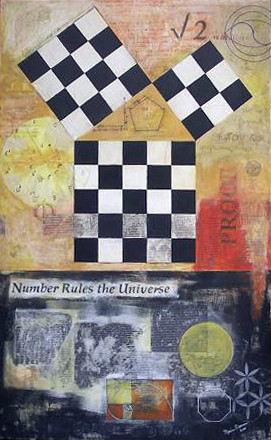Homage to Pythagoras
Marion Drennen
Quantum Connections
- Title: Homage to Pythagoras: Number Rules the Universe (A quote by Pythagoras)
- Size: Quadriptych 34” wide × 55” tall
- Medium: Acrylic on Board
Pythagoras (569–475 BC) was a Greek philosopher who made important discoveries in mathematics, astronomy and music theory. He is best known for the Pythagorean Theorem, which is depicted as the central motif, with the word PROOF alongside it. The Babylonians knew about this theorem 1000 years earlier, but Pythagoras proved it.
He also proved that irrational numbers exist, as shown in the upper mathematical proof. Phi, the irrational number known as the Golden Ratio, is found in the relationships between the sides, the edges and the vertices of the Platonic Solids, and was considered by the Pythagoreans to be so significant that they were sworn to secrecy on the subject. When Hippasus of Metapontum (who is credited with discovering the dodecahedron) divulged the secret of the existence of the irrational, he was thrown in the river and drowned. Phi, expressed to about 20,000 places is printed to the surface in the painting.
Pythagoras discovered the mathematics in music. By dividing a string into sections, so lengths have the ratios of 2:1, 3:2, 4:3, or 5:4 (octave, fifth, fourth, third), harmonic tunes result. He was quoted as having said, There is geometry in the humming of the strings
. In music theory, the diatonic scale, depicted on the left side of the theorem proof, is a 7-note musical scale with the pattern repeating at the octave (diatonic is translated by Greek, meaning literally “progressing through tones”).
Pythagoreans discovered the dodecahedron, the fifth regular/Platonic solid. Actually, Neolithic people of Scotland 2000 BC knew about these shapes, as evidenced by the stone carvings they left behind. However, the Pythagoreans gave the mathematical proof.
If you fit any regular solid just inside a sphere, all the vertices touch the inside of the sphere. If you fit a sphere just inside any regular solid, it touches all the faces of that regular solid.
The Pythagoreans believed that the universe consisted of a central, spherical earth surrounded by one of the five regular solids, in turn surrounded by a crystalline sphere surrounded by another regular solid, and so on until five spheres surrounded the earth, each circumscribed about a regular solid. The planets and the stars were attached and, as they rotated, created musical harmonies. The Pythagoreans believed most people couldn’t hear this “harmony of the spheres” because they had grown accustomed to it from birth, but that Pythagoras alone could indeed hear it.
This painting is on a board that has Golden Section Dimensions. The Space is broken up into the Golden Section Proportions.
